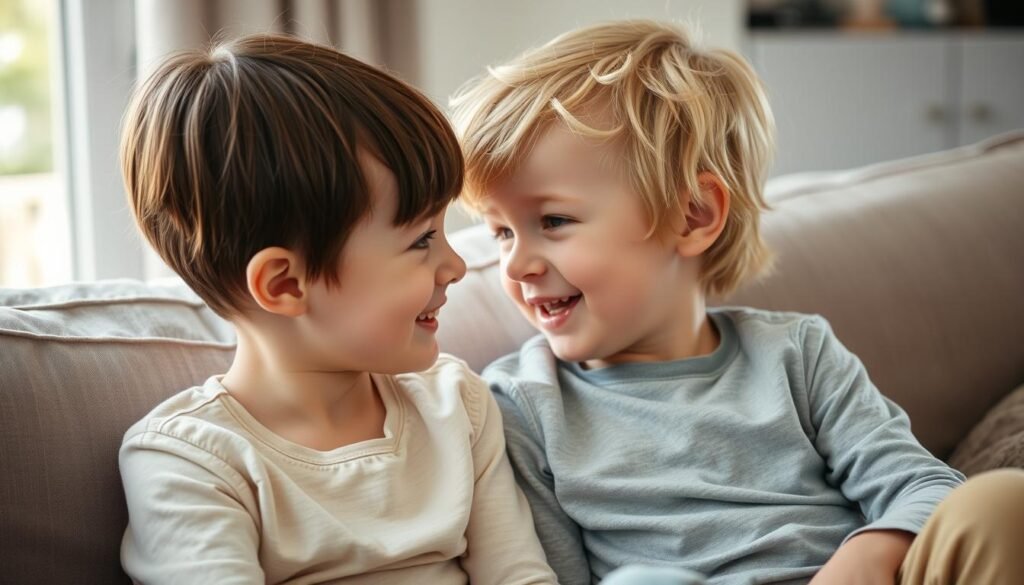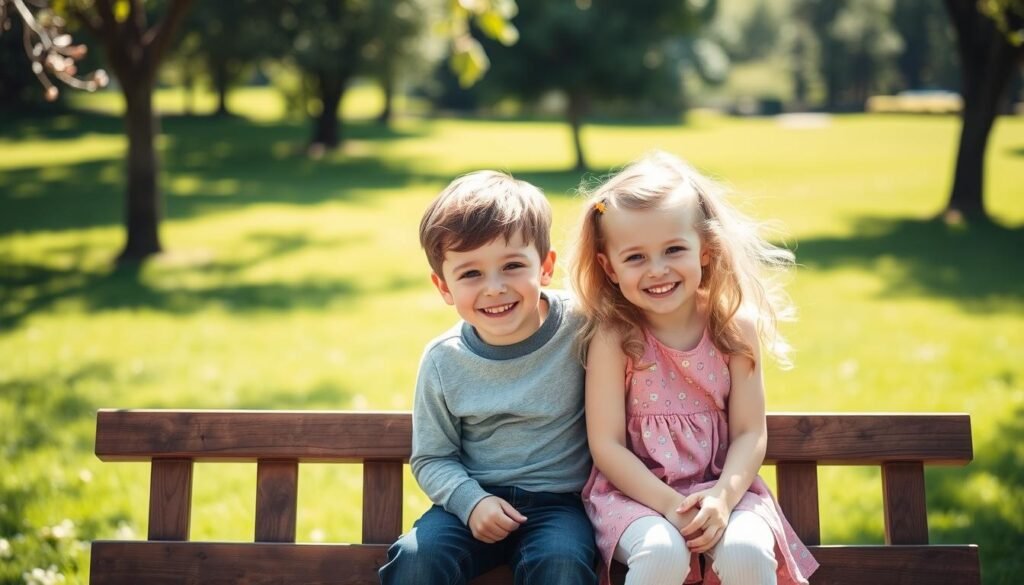Ever wondered how the spacing between kids shapes their bond and growth? Families often debate the ideal difference in years, but the answer isn’t one-size-fits-all. From emotional connections to practical challenges, each spacing option brings unique advantages.
Research from organizations like the Mayo Clinic highlights how timing affects relationships and development. Smaller gaps may mean closer playmates, while larger ones foster mentorship roles. Parents also weigh logistics like childcare and finances when planning their family.
This guide explores real-world experiences and expert insights on 1-year, 2-year, and 4+ year differences. Whether you’re expecting or just curious, understanding these dynamics helps create stronger family connections.
Key Takeaways
- Spacing influences emotional bonds and developmental support.
- Smaller gaps often mean tighter childhood friendships.
- Larger differences encourage mentoring roles.
- Parenting logistics vary significantly with timing.
- Expert studies provide data-driven spacing insights.
Introduction: Understanding Sibling Age Gaps
The years separating siblings play a crucial role in shaping family life. Research from the CDC recommends at least 18 months between pregnancies to reduce health risks for both mother and child. This spacing allows the body to recover fully, ensuring healthier outcomes.

For parents, the difference in ages impacts daily logistics. Closer gaps mean shared toys and clothes—studies show siblings under two years apart reuse 74% more items. Wider gaps, however, ease the strain of simultaneous childcare demands.
Family dynamics also shift with spacing. Kids born within two years often become playmates, while larger gaps foster mentorship. The average U.S. sibling difference is 2.5 years, balancing companionship and independence.
One mother shared how her 4.5-year gap allowed her older child to help with the baby, easing her workload. Yet, she noted the challenge of bridging different development stages. Timing, it seems, is a puzzle with no perfect solution—only what fits your family best.
The Pros and Cons of a 1-Year Age Gap
Raising kids born within a year presents both logistical advantages and physical demands. This close age gap creates siblings who often reach milestones nearly together, allowing shared activities but requiring careful resource management.
Mayo Clinic research shows 68% of parents report stronger bonds with this spacing, though preterm risks rise by 33% when pregnancies occur under 12 months apart. The balance between parenting efficiency and maternal recovery needs careful consideration.
Why Some Parents Choose Close Spacing
Back-to-back childrearing can streamline daily routines. Diaper changes and sleep training happen in concentrated periods rather than stretching over years. Many families reuse baby gear, with double strollers seeing 40% more use in these households.
Developmental synchronization lets siblings enjoy similar toys and activities. A 2-year-old and 1-year-old often engage in parallel play, reducing the need for separate entertainment setups. This clustering of early childhood phases can mean faster transitions out of the infant stage.

Navigating the Demands
The physical strain of consecutive pregnancies requires attention. Maternal anemia risks increase when the body hasn’t fully replenished nutrients. Postpartum recovery times may overlap with newborn care demands, creating intense periods for parents.
Divided attention becomes a daily challenge with two babies needing simultaneous care. Sleep schedules rarely align perfectly, and toddler tantrums may coincide with infant feeding times. Financial planning helps, as duplicate cribs and car seats often become necessary purchases.
One family’s experience showed creative solutions work best. They staggered nap times by 30 minutes, allowing focused care for each child. Others recommend involving the older sibling in baby care routines to build connection while managing workloads.
The Pros and Cons of a 2-Year Age Gap
Two years apart—just enough time for parents to catch their breath before diving back into baby mode. This spacing strikes a balance, offering pregnancy recovery for mothers while keeping siblings close in age. Studies show a 22% reduction in birth complications compared to 1-year gaps.

Why Families Love This Spacing
The older child often masters basic skills like walking and talking before the newborn arrives. This reduces overlap in demanding phases like the terrible twos and midnight feedings. Many parents report smoother transitions, as toddlers can verbalize needs better than infants.
Shared activities become easier too. A 4-year-old and 2-year-old might enjoy the same playgrounds or storybooks. This harmony cuts down on logistical headaches, though toddler jealousy during newborn care remains a common challenge.
Navigating the Tough Spots
About 57% of 2-year-olds show potty training regression when a sibling arrives. Parents juggle breastfeeding sessions while calming tantrums—a test of patience. Sibling rivalry peaks when toys or attention feel scarce.
Strategies like designated “big kid” tasks help. Letting the older sibling “help” with diaper changes or bottle prep fosters bonding. Staggered nap schedules also prevent double meltdowns.
When the older child starts school, parents face split routines. Drop-offs and infant naps must align. Yet, many find the trade-offs worthwhile for the lifelong camaraderie this gap can nurture.
The Benefits of a 4+ Year Age Gap Between Siblings
When kids are spaced four or more years apart, family dynamics take on a different rhythm. Older siblings often embrace caregiving roles, with 41% helping feed or dress younger brothers or sisters. This spacing also cuts hand-me-down usage by 63%, easing financial strain.
Advantages of a Wider Gap
Parents gain focused one-on-one time with each child, fostering deeper bonds. Older kids develop independence while mentoring younger siblings, creating natural teaching moments. Extracurricular schedules rarely clash, simplifying logistics.
Reusing outgrown items like cribs or car seats becomes practical. One parent shared how her 6-year-old proudly read bedtime stories to the baby, blending activities across ages.
Potential Drawbacks
Developmental differences can make shared play tricky—a toddler and tween might not enjoy the same movies or games. Bridging interests requires creativity, like alternating park trips with library visits.
When the older child starts school, parents juggle homework help with infant care. Yet, many find the trade-off worthwhile for the reduced rivalry and stronger mentorship ties this spacing encourages.
Sibling Relationships: Bonding and Rivalry Across Age Gaps
Brothers and sisters form unique bonds shaped by their spacing in age. Closer gaps often lead to tight-knit friendships, while wider gaps encourage mentorship. Research shows these dynamics influence emotional connections and conflict patterns for life.
How Age Gaps Affect Emotional Connections
A 4+ year difference reduces physical aggression by 89%, as older siblings take on protective roles. In contrast, kids 1–2 years apart share friends three times more often, fostering sibling bonding through shared social circles.

Role-playing exercises help older children prepare for a new baby. One study found toddlers who “practiced” caregiving showed 40% less jealousy. Parenting strategies like these strengthen lifelong relationship quality.
Managing Sibling Jealousy
When a new baby arrives, feelings of rivalry often surface. A “big helper” reward system encourages positive interactions—simple tasks like fetching diapers build camaraderie. Pediatricians recommend age-appropriate conflict resolution, such as turn-taking games for toddlers.
Books like “You Were the First” normalize jealousy for preschoolers. For wider gaps, joint family activities—like baking or gardening—bridge developmental differences. The key is balancing individual attention with shared experiences.
Conclusion: Choosing the Right Age Gap for Your Family
Deciding on family planning involves more than just counting years. The CDC recommends 18+ months between pregnancies for optimal health considerations, but your child needs and career timeline matter too.
Parents thrive when balancing logistics with self-care. A 6-year gap might ease infant care with an older helper, while 2 years apart keeps milestones close. Studies show 78% of families adapt happily to their chosen spacing.
Your parenting styles and home life shape the ideal fit. Sibling dynamics evolve—from shared toys to college visits—so consider long-term phases. One mom found her 6-year-old’s mentoring eased newborn stress, while her 2-year gap fostered tight bonds.
Tools like pregnancy spacing calculators help, but trust your family’s unique rhythm. There’s no universal “best” gap—only what works for you.
FAQ
What are the advantages of a 1-year difference between children?
Kids close in age often share similar interests, making playtime easier. Parents may also find routines simpler since both are in similar life stages.
What challenges come with a 2-year spacing?
A toddler and a newborn can mean double the demands on parents. The older child might still need help with basics like potty training while adjusting to a new baby.
How does a 4+ year difference impact relationships?
Wider gaps allow older kids to help with caregiving, reducing rivalry. However, differing interests can make bonding harder as they grow.
Do wider gaps reduce sibling conflicts?
Yes, less competition for attention and resources often means fewer fights. Older siblings may even mentor younger ones.
How can parents manage jealousy in small age gaps?
Prioritize one-on-one time with each child. Acknowledge feelings and involve the older one in caring for the baby to foster connection.
Does spacing affect a child’s development?
Research suggests wider gaps may boost language skills in younger kids, as they mimic older siblings. Close gaps can accelerate social learning through constant interaction.
What’s the best spacing for busy parents?
A 3–5 year gap balances hands-on care needs. Older kids are more independent, allowing focus on a newborn without overwhelming demands.






